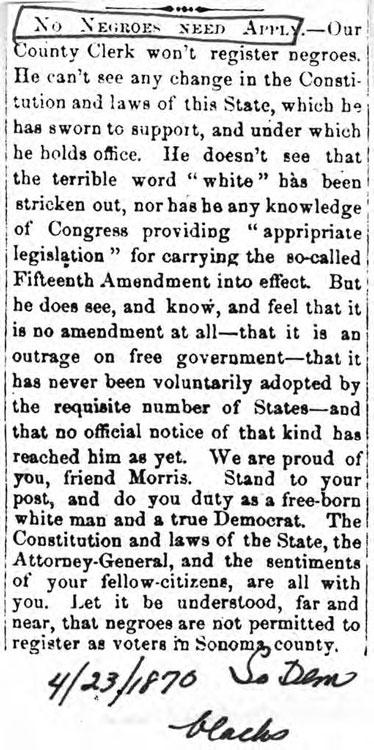Black Americans in Santa Rosa

‘No Negroes Need Apply’ is the [1870] Press Democrat headline on a story indicating that the county clerk will not register blacks to vote, saying he ‘can't see any change in the Constitution.’
— LeBaron, Gaye. “A Town’s History Is Not Always What We'd Like It to Be.” Santa Rosa Press Democrat, January 17, 1988.
Black families had moved north from wartime jobs in the Bay Area. Most were originally from the Southwest — Texas, Oklahoma — with money in their pockets from defense industry jobs and no intention whatsoever of going ‘back South.’
— LeBaron, Gaye. “Santa Rosa’s Fight to Equity Has a Long Way to Go.” Santa Rosa Press Democrat, June 22, 2020.
The Great Migration of the 1920s saw major population shifts when African Americans from the South moved en masse to northern cities like Detroit, Chicago, and New York. Only later during what scholars refer to as the Second Great Migration in the early 1940s did a large number of African Americans migrate west to California from southern and northern U.S. cities alike. Northern California held a certain promise for these Black travelers, who sought economic opportunities afforded by the bustling Bay Area as well as refuge from southern racism and northern segregation. However, upon their arrival in the North Bay, many Black Americans would encounter a harsh reality of discrimination and racial bigotry. Many white residents in the North Bay did not welcome African Americans as their neighbors and co-workers, leading to housing and employment discrimination, increased residential segregation, ‘white flight’ into the suburbs, rampant racial tensions, police brutality, and humiliations of all types.
Today fewer than two percent of Sonoma County residents are African American — making the county one of the least populated by African Americans across all of Northern California. Yet the paucity of Black representation in Sonoma County is no indication that the region lacks in remarkable Black stories and pioneers. Even in the face of persistent racism, African Americans of the North Bay thrived, accumulating wealth, property, political clout, and a legacy that has left an indelible mark on Sonoma County as we know it today.
Santa Rosa did have Black residents of course, but it would be a stretch to suggest that there were enough to be considered a ‘Black community.’ There were, however, Black citizens who were trying hard to make that happen.
— LeBaron, Gaye. “Santa Rosa’s Fight to Equity Has a Long Way to Go.” Santa Rosa Press Democrat, June 22, 2020.
Further Reading
De Graaf, Lawrence B., et al. Seeking El Dorado: African Americans in California. Los Angeles, California, Autry Museum of Western Heritage, 2001.
McGriff-Payne, Sharon. John Grider's Century: African Americans in Solano, Napa, and Sonoma Counties from 1845 to 1925. iUniverse, Inc., 2009.
Spearman, A. Darius. Rivers of Hope, Rivers of Change: the African American Experience in Sonoma County. Santa Rosa, California, Sonoma County Museum, 1997.

